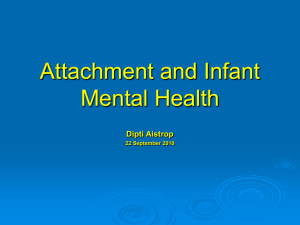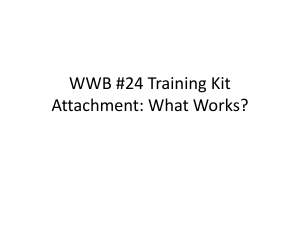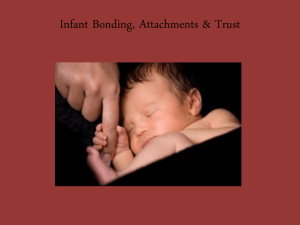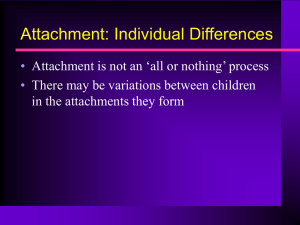Parent Child Engagement, A Co-Regulation Process
advertisement
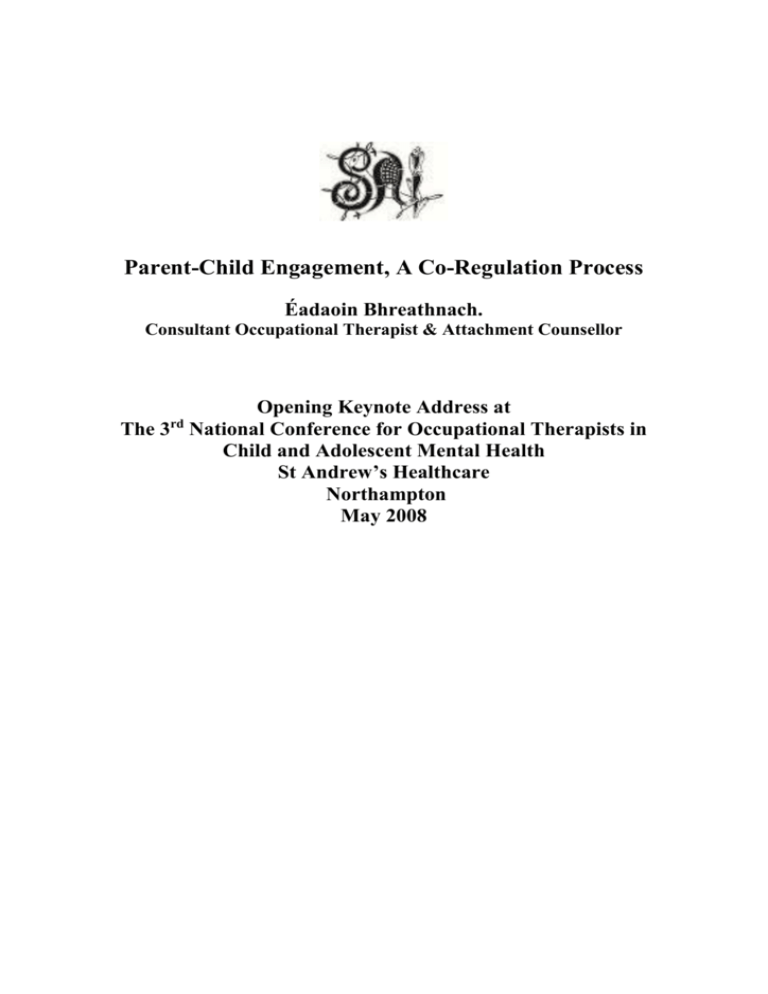
Parent-Child Engagement, A Co-Regulation Process Éadaoin Bhreathnach. Consultant Occupational Therapist & Attachment Counsellor Opening Keynote Address at The 3 National Conference for Occupational Therapists in Child and Adolescent Mental Health St Andrew’s Healthcare Northampton May 2008 rd The Regulated Secure Pattern. The primary role of parents is to emotionally regulate their child. This process of regulation begins in the womb environment. The baby feels what the mother is feeling, so if the mother is nurtured and emotionally secure during the pregnancy it augurs well for her unborn child. At this stage the role of the father is to be both nurturing and protective towards his partner and unborn infant. When the infant is born he comes into the world with highly predictable responses to both positive and negative stimuli. These responses in turn shape those of the parents to set up a mutual feedback system appropriate to the baby (Brazelton, 1991). The engagement process of co-regulation thus begins. If the baby produces a pleasing behaviour, such as a smile, the parents positively reinforce it but when the baby shows signs of distress, anxiety levels in the parents are raised. The parents’ response will be dependent on their own early attachment experiences of parenting, and on whether they have fully metabolised their experiences of distress. Good enough parents are able to regulate their infant’s negative states as they have the ability to contain their infant’s distress, modulate it, give it meaning, and return this transformed affect in the form of holding, or a meaningful comment (Hamilton, 1992). The role of the mother in early infancy is to be primarily involved in nurturing and comforting her child. Her primary concerns are enabling her infant to achieve psychobiological regulation. She facilitates this by providing predictably nurturing care for example; feeding her infant when he is hungry, establishing a good bedtime routine, and protecting him from harmful infections. In time the mother not only becomes identified as the source of comfort but the child internalises her pattern of care and thus learns how to self comfort and self care. Fathers are on other hand are seen to stimulate their infants differently even in the early weeks (Yogman et al., 1976). They are more likely to play stimulating games thus heightening their baby’s state of excitement. The rhythm of interaction is therefore quite different from the mother’s as it involves higher peaks and longer periods of recovery (Brazilton, 1990). As the infant matures the father increasingly makes demands on him to become assertive against gravity and experience natural consequences. This leads to the development of good body scheme that in turn facilitates the process of separation, independence, and a capacity to face the outer world. Through this interaction the child becomes resilient, learns how to face up to challenges and how to remain regulated and focused, even in a heightened state of arousal. In other words he internalises the father’s pattern of interaction. The ultimate goal of the good enough parents is to teach their child, through their interactions with him, how to take good care of himself, face up to and take on challenges, and in time, as an adult, enter into a reciprocal loving relationship which involves repeating the pattern of good enough parenting. E. Bhreathnach. Parent Child Engagement A Co Regulation Process 2 Over Regulation & Under Regulation When children do not experience good enough parenting it impairs the ontogeny of attachment and self-regulatory systems (Greenspan, 1981). This maybe traced back to pregnancy. If the mother is stressed she produces stress hormones in the blood. These will be going across the placenta into her baby. Repeated exposure to stress during pregnancy can make the infant more prone to stress after he is born and more likely to suffer from self regulatory dysfunction. Schore (1994) suggests that the mother’s pattern of response to stress may either support a predisposition to passive avoidance (parasympathecially biased, dissociation continuum), which leads to a limited capacity to consciously experience intense positive or negative affect and to a susceptibility to overregulation disturbances or she may support an approach avoidance response (sympathetically biased, hyperarousal continuum) and a predisposition to heightened expressions of intense emotionality and a susceptibility to under-regulation disturbances. In behavioural terms the overregulated child may present as under-reactive to stimuli, his activity levels are low, and he may present as highly focused and compliant in the presence of adults. Children who are predisposed to under regulation disturbances present as: impulsive, hyperactive, distressed and angry. Fathers also influence their child’s autonomic response to stress and their stress pattern may differ from that of the mother’s. One parent may be predisposed to operate in the dissociation continuum while the other parent operates in the hyperarousal continuum. The sensitised child will operate in which ever of these modes he deems to be the most adaptive for survival when in the presence of the stressed parent. In time this response becomes generalised to other anxiety provoking interactions even when there is no actual threat. Affect Regulation & Emotional Development Sroufe & Rutter (1984) propose that atypical patterns of self-regulation and affect expression are seminal to the later development of disorders of affect. The child who is anxiously inhibited becomes emotionally avoidant and this translates into avoidance of proximity, precocious independence and defensiveness to nurturing touch. In adulthood these individuals are uncomfortable if people become too close. They fear true intimacy and do not like to be dependent on others or others to be dependent on them. They are the least emotionally expressive and may be subject to strong shame (Gilbert, 1992). The child who is insecure resistant becomes clingy, highly dependent, impulsive and ill tempered. In time these children become explosive (Caspi, Elder, & Bem 1987). In adult life they fear rejection and abandonment from family and friends. They are highly sensitised to separations so they are clingy, possessive, jealous, and exaggerate affective expression (Gilbert, 1992). These individuals also have a tendency to blame others for their difficulties. There are another group of children who are described as disorganised/disorientated. They display conflicting patterns in the presence of the parent who is both the source of comfort and the source of alarm (Lyons-Ruth & Jacobvitz, 1999). The infant as a result experiences contradictory tendencies both to approach and to flee from the parent. E. Bhreathnach. Parent Child Engagement A Co Regulation Process 3 Attachment & Psychopathology in Adulthood Psychiatric patients show an inability to adapt internally to stress (Kolb, 1977) and this is expressed in a continuing activation or inhibition of organ systems. Dozier et al (1999) suggest that dismissing states of mind should be associated with disorders that involve turning attention away from one’s own feelings, and preoccupied states of mind should be associated with disorders that involve absorption in one’s own feelings. In their review of the very limited available research which specifically looked at attachment patterns and psychopathology they found that insecure avoidant types tend to be closely associated with schizoid-type disorders, while insecure clingy/resistant and unresolved/disorientated categories are associated with anxiety, substance abuse, and borderline personality disorders. Implications for Intervention with Children Therapists working in CAMHS, in residential settings or with looked after children need to understand the impact that insecure attachment has on the child’s cognitive, sensory, and motor development. The insecure anxious child will only take in information that he deems relevant to survival (Perry, 1995) and as a result he may fail to pick up salient cues when involved in an activity or when interacting with others. Top down approaches and assessments that invite the child to consciously reflect on his difficulties may only reinforce his sense of failure and lack of control. This in turn will heighten anxiety. Anxiety around performance deregulates muscle tone and negatively affects the capacity to attend and learn, thus the child finds himself in a self-defeating cycle. Overregulated and under regulated children respond differently to sensory experiences. The overregulated, inhibited, avoidant child usually responds well to excitatory vestibular intake as it releases inhibition and facilitate assertiveness. He is likely to be tactile defensive but the underlying reasons are emotional not sensory and therefore need to be treated differently. The overregulated avoidant child is very good at camouflaging what he really feels and thinks. He may appear to be underresponsive, or even regulated and display positive affect, when in fact he is in freeze/compulsively compliant mode. The under-regulated, insecure resistant child on the other hand tends to become impulsive and aggressive when exposed to fast movement and unstable surfaces. He may also react aggressively to nurturing touch if there has been a history of violence or sexual abuse. Children with a significant history of trauma are frequently diagnosed as having ADHD. There is a tendency to dissociate their symptoms from their attachment history and ongoing family relationships. Their flight and fear behaviours are often misunderstood and they may increasingly become aggressive and oppositional if their emotional issues are not addressed. Therapists may also see fluctuations in children’s muscle tone that are associated with different emotional states. This constitutes a shift from an active (sympathetic) arousal state to a passive parasympathetic arousal state (Schore, 1994). Aggression leads to an increase in tone but when the child is ashamed, disgusted or depressed his muscle tone can plummet. I have seen children who can happily swing and hang upside down on a trapeze bar to not being able to mount a bolster swing or climb onto a large inflatable cushion because a parent has failed to turn up for access or is rejecting towards them. E. Bhreathnach. Parent Child Engagement A Co Regulation Process 4 The more aware I have become of the regulating and deregulating nature of attachment relationships the more I recognise that it is essential to involve the child’s significant attachment figures (this can include the child’s classroom assistant) in therapy. I have observed that if treatment is carried out by the significant caregiver in a playful engaging and regulating manner it speeds up the treatment process and is more effective than therapist child interventions. Attachment appears to be the ‘magic bullet’ if we know how to appropriately use it. Yet many of the traditional therapeutic approaches, including Sensory Integration, detach the child from the parents. How often do we hear statements such as “the child is much better behaved without the parent”, “I can get through more when the parent isn’t present” or “I work in a school setting where we don’t have access to parents” If the parents are present they more often than not are cast in the role of passive compliant observers. In Sensory Integration the therapist takes on the role of regulator and creates an artificial regulating environment in which the child’s needs are met in a very intense and fun way. Advice is given to parents regarding the developmental needs of the child but the context in which the home programme is carried out by the parents will colour the child’s experience of it. The capacity of the parents to self-regulate and to regulate their child is not usually assessed nor indeed facilitated. There is the potential that the child, as a result of our interventions, may either become more resistant to his parent’s attempt to engage or feel more isolated and disengage. To avoid this we must involve parents or significant caregivers in the process of intervention. Enable them to become the good enough parent who sensitively responds to the ongoing needs of the child. The Therapeutic Process Emotionally secure parents instinctively know when to up regulate and when to down regulate their child, when to nurture and when to challenge. The end result is a child who can flexibly adjust expression of feelings and impulses to suit situation requirements (Sroufe, 2005). Sensory Attachment Intervention (SAI) attempts to replicate this by providing nurturing and challenging spaces. Parents are invited to participate in child led play. Sessions are filmed so that parents can observe and learn about the process of self-regulation and co-regulation. They learn how to activate and how to inhibit arousal states, in a fun and nurturing way that is appropriate to the sensory-attachment needs of their child. The sessions are deliberately not scripted, as the dialogue between parents and the child has to come from within. This allows the parents and their child to take ownership of the process. It also allows the therapist to observe the true patterns of parent-child interaction and regulation. The therapist then decides whether particular sessions will involve one or other parent or both. While male attachment figures tend to be used to up regulate and contain impulsive aggressive behaviours, and female attachment figures tend to be used to down regulate and help the child cope with nurturing space and alone womb space, the opposite can occur. The choice will depend on the nature of the relationship, the availability of the parent, and on the regulation pattern of the parent. As engagement is a co-regulating process the therapist has to be mindful of ensuring that the parent remains regulated through out the session. For example in the case of under regulated dyads the therapist will structure the environment where activities involve active proprioceptive intake, so that both parties will be naturally down regulated. In the case of a child who is under-regulated and a parent who is overregulated and inhibited, the parent might be encouraged to sit on a bolster swing E. Bhreathnach. Parent Child Engagement A Co Regulation Process 5 and get the child to push. The movement will activate the arousal response in the parent while the effort the child experiences pushing the parent will down regulate and inhibit impulsivity. Dyads are varied and complex particularly when an insecure child presents with significant sensory processing issues. The child may present as emotionally clingy but sensory avoidant because they are posturally insecure or tactile defensive. This type of child could potentially be misdiagnosed as disorganised if classified from an attachment perspective. The tactile defensive child will tend to display an approach avoidant response, unlike the clingy resistant child who may display an approach attack response. The posturally insecure child may display freezing, stilling, or asymmetrical movements when posturally challenged. These patterns are compensatory in order to avoid falling. If however the child only displays these sensory motor patterns in the presence of a specific caregiver, and when they are not being posturally challenged, then it could be assumed that the behaviours are due to the attachment relationship. SAI therapy also caters for the child who cannot rely on his parents to regulate him. The child needs to learn how to emotionally self-regulate, which includes recognition of emotional states and knowledge of regulating strategies. There are already selfregulation programmes in the OT field such as the Alert Programme but these programmes are not designed for children with insecure attachments. Children who are highly insecure do not want to be told that their ‘engine is running high’ i.e. they are in a state of high arousal. Being told may actually trigger the child into becoming even more impulsive and aggressive. The insecure resistant child cannot take ownership of his feelings. He is overwhelmed by them and tends to lay blame for his behaviour elsewhere. The insecure avoidant child may feel intense shame and may over inhibit his behaviour as a result of a passing comment from the therapist. Insecure children prefer to distance themselves from behavioural states that overwhelm them. They find it easier if discussion of these states is through the use of stories. SAI focuses on regulation of arousal states thus the stories used in the children’s programme The Just Right State© are about survival behaviours. Children learn about how to achieve the just right state whether it is to fall asleep at night, play with friends or attend in class. The Just Right State© programme is designed to be carried out with groups of primary school children over a six week period. The characters in the stories represent the different survival responses such as fear, flight, or fight. The characters introduce themselves, describe their own behaviour, and then say what helps them to achieve the just right state of arousal. The children tend to identify with the characters that are most like them. They then feel it is okay to say that they sometimes feel like that as well, and are encouraged to talk about what strategies they use to help them feel better. They also take ideas from the characters as to what might work best for them. The Just Right State© parent programme has also recently been developed at the request of NIACRO (Northern Ireland Association For The Resettlement of Offenders). The Just Right State © programme is now being field tested as a tool for teachers, therapists, and social care workers. E. Bhreathnach. Parent Child Engagement A Co Regulation Process 6 In Conclusion. Therapists working in CAMHS recognise that they have to address social and emotional issues in addition to children’s developmental problems. The current difficulty is that most interventions take a split approach, that is self-regulation and co-regulation are looked at from either a sensory processing perspective or an attachment perspective. This can unfortunately lead to misdiagnosis and use of inappropriate interventions. Sensory Attachment Intervention is an occupational therapy model of approach, that looks at attachment and sensory processing from an organismic, neurobehavioural perspective. The Occupational Therapist with this integrated approach is uniquely placed to provide practical solutions to children and their parents who previously have failed to respond to intervention. SAI is now typically used for highly traumatised children and their parents (birth, foster and adoptive). Its principles of practice come from good enough parenting as Mother and Father Nature know best. References. Brazelton, T. B., & Cramer, B.G. (1990). The Earliest Relationship. London: Karnac Books. Caspi, A., Elder, G. H., Jr., & Bem, D.J. (1987). Moving against the world: Lifecourse patterns of explosive children. Developmental Psychology, 22, 303-308. Dozier, M. Stovall, K.C., Albus, K.E. (1999). Attachment and psychopathology in adulthood. In J. Cassidy, P. R. Shaver (Eds.), Handbook of Attachment: Theory, Research, and Clinical Application (pp.520-554). New York: Guilford Press. Gilbert, P. (1992). Counselling for depression. London: Sage Publications. Greenspan, S. I. (1981). Psychopathology and adaptation in infancy in early childhood. New York: International Universities Press. Hamilton, N.G. (1992). Introduction. In N.G. Hamilton (Ed.), From Inner Sources: New Directions in Object Relations Psychotherapy. Northvale NJ: Jason Aronson. Kolb, L.C. (1997). Modern Clinical Psychiatry. Philadelphia: W. B. Saunders. Lyons-Ruth, K. & Jacobvitz, D. (1999). Attachment Disorganization: Unresolved loss, relational violence, and lapses in behavioral and attentional strategies. In J. Cassidy, P. R. Shaver (Eds.), Handbook of Attachment: Theory, Research, and Clinical Application (pp.520-554). New York: Guilford Press. Perry, Bruce D., Pollard, Ronnie A., Blakley, Toi L., Vigilante, Domenico. (1995) Childhood trauma, the neurobiology of adaptation, and "use-dependent" development of the brain: How "states" become "traits". Infant Mental Health Journal, Vol. 16, No. 4, Winter Edition. Schore, A. (1994). Affect regulation and the origin of the self. The neurobiology of emotional development. New Jersey: Lawrence Erlbaum Associates. E. Bhreathnach. Parent Child Engagement A Co Regulation Process 7 Sroufe, L.A., & Rutter, M. (1984). The domain of developmental psychopathology. Child Development, 55, 17-29. Sroufe, L.A. (2005). Attachment and development: a prospective, longitudinal study from birth to adulthood. Attachment & Human Development, Vol.7, No. 4, 349-368. Yogman, M. W., S. Dixon, E. Tronik, L. Adamson, H. Als, and T.B. Brazelton. Father-infant interaction. Paper presented at meeting of American Pediatric Society, ST. Louis, Missouri, 1976. E. Bhreathnach. Parent Child Engagement A Co Regulation Process 8
